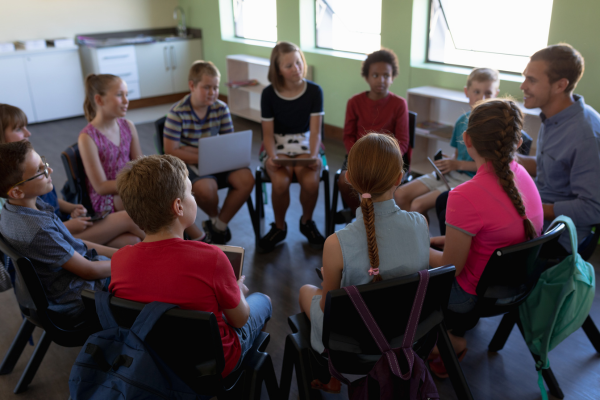By: Anna Hukill
Highlights:
- This Research in Brief blog is part of the School Mental Health series highlighting work and resources for mental health professionals.
- This brief originated from the Virginia Partnership for School Mental Health (VPSMH) project, which partners with VA school divisions and institutions of higher education to expand support for school mental health services.
- This brief summarizes research on school staff and youth perspectives of tier 1 restorative practices classroom circles.

In this qualitative study, researchers gathered perceptions from staff and students about the relationship between restorative practices, community-building circles, and social- emotional learning. Data included beginning- and end-of-year surveys about staff perspectives on implementation, semi- structured interviews with staff, and surveys about student participation. Results showed a strong association between community- building circles and social-emotional learning (SEL). The challenges mentioned included circle participation, equitable access, and conflict between discipline and restorative practices. This supports the idea that restorative practices need to be implemented school-wide.
Importance
School counselors, especially in elementary schools, often deliver short lessons and can incorporate community circles into their curriculum. This is an important opportunity to advocate for equitable access to classrooms. Community circles are a proactive way of building strong peer relationships and strategies for resolving conflict.
Equity Considerations
- Ensure that all students have access to participate in the circle (e.g., alternative seating, multiple modes of participation).
- Carefully consider opening and closing questions that all students can connect with.
Practitioner Tips
- Community building circles have the potential to be a strong tool for improving social-emotional competence in students.
- Teachers can seamlessly incorporate such circles into pre-existing group time by setting a clear routine (ex. greeting, opening question, SEL topic of the day, closing statement/activity).
- Teachers and students report positive increases in student participation, communication, and sense of belonging.
- Circles can be used among staff to develop a strong sense of school community.
Reference
Garnett, B. R., Kervick, C. T., Moore, M., Ballysingh, T. A., & Smith, L. C. (2022). School staff and youth perspectives of tier 1 restorative practices classroom circles. School Psychology Review, 51(1), 112-126. https://doi.org/10.1080/2372966X.2020.1795557
If you have any comments or questions about this post, please email Youth-Nex@virginia.edu. Please visit the Youth-Nex Homepage for up to date information about the work happening at the center.
Author Bio: Anna Hukill is a graduate student in the Counselor Education program at the University of Virginia, pursuing the School Mental Health emphasis offered to trainees through the Virginia Partnership for School Mental Health. Trainees in this emphasis complete additional coursework and field experience requirements that prepare them to take on leadership roles in addressing the mental health needs of students in K-12 schools.
